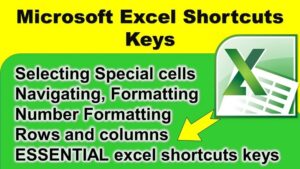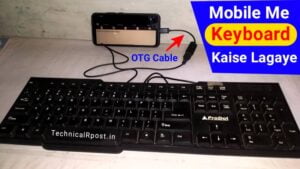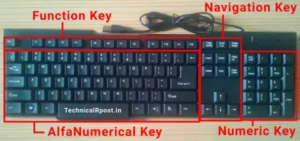Common Keyboard Shortcuts in Computer, 100 shortcut keys in Computer.
Hello friends, if you are a computer user, and when you work on any computer, then you have to use the mouse again and again. And a lot of time is consumed in bringing an option, due to which a lot of time is wasted. So, save time by using these 100 shortcut keys in Computer and you become a smart computer user.
Table of Contents
Common Keyboard Shortcuts in Computer

- Ctrl + C : Copy selected items (Text, Files, Folders etc).
- Ctrl + V : Paste recently Copied items.
- Ctrl + X : Cut selected items (Text, Files, Folders etc).
- Ctrl + A : Select everything in an open document, or current window.
- Ctrl + B : Bold Selected Text.
- Ctrl + P : Open print dialog box.
- Ctrl + O : Open file in some application.
- Ctrl + D : Delete selected items.
- Alt + F4 : Close currently open window.
- Ctrl + Z : Undo last action.
- Ctrl + Y : Redo an action.
- Alt + Tab : Switch between open windows.
- Alt + Enter : Display properties for the highlighted item, similar to Right-Click Options.
- Alt + Spacebar : Display shortcut menu for the currently open window.
- Alt + Left Arrow : Go back if there is a previous history in the window, in programs such as browsers.
- Alt + Right Arrow : Go forward, again useful in browsers.
- Alt + Page Up : Scroll up an entire screen length.
- Alt + Page Down : Scroll down an entire screen length.
- Ctrl + Alt + Tab : With the aid of some of the arrow keys, you can select from all open windows.
- F1 : Display the help menu.
- F2 : Rename currently selected items.
- F3 : Search for a certain file or folder.
- F4 : Show address bar list in File Explorer.
- F5 : Refresh the window that is open currently.
- F6 : Toggle different screen elements/keyboard shortcuts related to the program currently open.
- F10 : Show the menu bar in the application that is currently open.
- Esc : Stop or leave the current action.
- Shift + Delete : Delete the permanent selected item, without having it go to the recycle bin first.
Read Also: keyboard Hindi typing chart pdf file download
Browser Keyboard Shortcuts
- Ctrl + D : Bookmark the current web address that is open in your browser.
- Ctrl + I : View the saved favourites window.
- Ctrl + J : View the browser downloads window.
- Ctrl + H : Show browser history window.
Windows Key Shortcuts
- Windows + L : Lock the computer
- Windows + D : Switch between the currently open window and showing the desktop.
- Windows + F1 : Opens the Windows help and support menu.
- Windows : Open/Close the start menu.
- Windows + B : Highlight the notification area.
- Windows + F : Open the Feedback Hub window.
- Windows + I : Open the settings window.
- Windows + K : Open the connect/stream to devices bar.
- Windows + M : Minimize all currently open windows.
- Windows + Shift + M : Re-open all minimized windows.
- Windows + P : Opens display mode menu.
- Windows + Q : Open Cortana Search menu.
- Windows + R : Open the Run window.
- Windows + T : Cycle through the apps that are currently on the task bar.
- Windows + V : Rotate through the notifications.
- Windows + , : Take a brief look at the desktop (as long as it is held down).
- Windows + Z : Shows all the commands that can be used in the currently open window.
- Windows + 1 : Start the application pinned to the start bar in the first position, if already open, it switches to that window.
- Windows + 2 : Start the application pinned to the start bar in the second position, if already open, it switches to that window.
- Windows + 3 : Start the application pinned to the start bar in the third position, if already open, it switches to that window.
- Windows + 4 : Start the application pinned to the start bar in the fourth position, if already open, it switches to that window.
- Windows + 5 : Start the application pinned to the start bar in the fifth position, if already open, it switches to that window.
- Windows + 6 : Start the application pinned to the start bar in the sixth position, if already open, it switches to that window.
- Windows + 7 : Start the application pinned to the start bar in the seventh position, if already open, it switches to that window.
- Windows + 8 : Start the application pinned to the start bar in the eighth position, if already open, it switches to that window.
- Windows + 9 : Start the application pinned to the start bar in the ninth position, if already open, it switches to that window.
- Windows + Shift + 1 : Start a new window/instance of the application pinned to the start bar in the first position, if already open, it switches to that window.
- Windows + Shift + 2 : Start a new window/instance of the application pinned to the start bar in the second position, if already open, it switches to that window.
- Windows + Shift + 3 : Start a new window/instance of the application pinned to the start bar in the third position, if already open, it switches to that window.
- Windows + Shift + 4 : Start a new window/instance of the application pinned to the start bar in the fourth position, if already open, it switches to that window.
- Windows + Shift + 5 : Start a new window/instance of the application pinned to the start bar in the fifth position, if already open, it switches to that window.
- Windows + Shift + 6 : Start a new window/instance of the application pinned to the start bar in the sixth position, if already open, it switches to that window.
- Windows + Shift + 7 : Start a new window/instance of the application pinned to the start bar in the seventh position, if already open, it switches to that window.
- Windows + Shift + 8 : Start a new window/instance of the application pinned to the start bar in the eighth position, if already open, it switches to that window.
- Windows + Shift + 9 : Start a new window/instance of the application pinned to the start bar in the ninth position, if already open, it switches to that window.
- Windows + Alt + 1 : Open the action bar settings list for the application pinned to the start bar in the first position.
- Windows + Alt + 2 : Open the action bar settings list for the application pinned to the start bar in the second position.
- Windows + Alt + 3 : Open the action bar settings list for the application pinned to the start bar in the third position.
- Windows + Alt + 4 : Open the action bar settings list for the application pinned to the start bar in the fourth position.
- Windows + Alt + 5 : Open the action bar settings list for the application pinned to the start bar in the fifth position.
- Windows + Alt + 6 : Open the action bar settings list for the application pinned to the start bar in the sixth position.
- Windows + Alt + 7 : Open the action bar settings list for the application pinned to the start bar in the seventh position.
- Windows + Alt + 8 : Open the action bar settings list for the application pinned to the start bar in the eighth position.
- Windows + Alt + 9 : Open the action bar settings list for the application pinned to the start bar in the ninth position.
- Windows + Tab : Cycle through recently open or used applications/windows.
- Windows + Ctrl + B : Switch to the application/window that showed a notification.
- Windows + Up Arrow : Maximize the current window.
- Windows + Down Arrow : Minimize the current window.
- Windows + Left Arrow : (if Split) Maximize the window that is being displayed on the left side of the screen.
- Windows + Right Arrow : (if Split) Maximize the window that is being displayed on the right side of the screen.
- Windows + Home : Minimize all but the current active window.
- Windows + Spacebar : Change language and keyboard layout options.
- Windows + Ctrl + Spacebar : Change a previous selection option for language and keyboard layout.
File Explorer Shortcuts Keys
- Alt + D : Select the address bar.
- Ctrl + E : Select the search bar.
- Ctrl + N : Open new window.
- Ctrl + W : Close selected window.
- Ctrl + Mouse Scroll Wheel : Change size and look of file and folder icons/thumbnails.
- Ctrl + Shift + E : Show all the folders about the highlighted folder.
- Ctrl + Shift + N : Make a new folder.
- Num Lock + * : Show all the sub folders of the highlighted folder.
- Num Lock + + : Show the contents of the highlighted folder.
- Alt + P : Show the preview pane.
- Backspace : Go to the previous folder.
- Alt + Up Arrow : View the folder that the current folder was in.
- Alt + Left Arrow : Show the previous folder.
- End : Show the bottom of the current open window. (If applicable).
- Home : Display the top of the current open window. (If applicable).
10 shortcut keys in computer
Ctrl + C : Copy selected items (Text, Files, Folders etc).
Ctrl + V : Paste recently Copied items.
Ctrl + X : Cut selected items (Text, Files, Folders etc).
Ctrl + A : Select everything in an open document, or current window.
Ctrl + B : Bold Selected Text.
Ctrl + D : Delete selected items.
Alt + F4 : Close currently open window.
Ctrl + Z : Undo last action.
Ctrl + Y : Redo an action.
Window + Spacebar : Change input language.
Shortcut key to delete a file or folder permanently
If you want to delete any file or folder permanently, so that select your file or folder and then press Shift + Delete button.
- YouTube shortcut keys | How To skip 10 seconds on YouTube

- MS Excel Shortcuts Keys List | Microsoft Excel Shortcuts Keys

- 100 shortcut keys in Computer

- Mobile me keyboard kaise lagaye? | मोबाइल को कीबोर्ड से कनेक्ट कैसे करते हैं?

- What is the most useful key in keyboard of a computer | कीबोर्ड में सबसे मोस्ट यूजफुल कीज कौन सी है?





